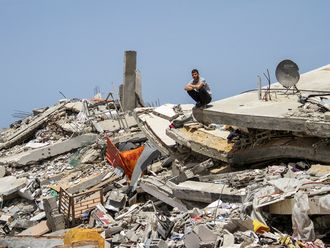
Barely five months after they first made a run for Sana’a, Yemen’s Al Houthi rebels gave the country’s political factions a three-day ultimatum to reach a political agreement on power sharing before, or so they claimed, their challenged leaders would take over. Is this realistic and should Al Houthis grab power in Sana’a, would we see a break-up of the country?
Al Houthis, who cavalierly name themselves after Hussain Badriddin Al Houthi, a renegade commander who was reportedly killed by the Yemeni army in a September 2004 battle, but who boastfully also refer to themselves as “Supporters of God” (Ansar Allah), are an insurgent group. They happen to be Zayidis, followers of the second largest branch of Shiite Islam, named after Zayed Ibn Ali, and may constitute approximately 40 per cent of the Yemeni population, although no proper statistics confirm this figure. Today, the nominal leader of the militia is Hussain’s father, Badriddin Al Houthi, though it is unclear whether he is merely a spiritual leader or also a warrior.
In the world of religious competition that murky politicians abscond, Zayidi laws are not that much more different from Sunni rulings, although Shiites in general and Zayidis in particular believe in the Imamate as a cornerstone of religion. This is a vexing point to say the least, because the effort mimics Iran and, more importantly, because it negates much of the contemporary history of Yemen after the fall of the Imamate, or the Mutawakkilite Kingdom of Yemen, in 1962. The three monarchs of the Imamate, Yahyah Hamid Al Deen, Ahmad Bin Yahyah and Mohammad Al Badr were Zaydis, but also diehard Arab nationalists. This was a critical feature to bear in mind at a time when Al Houthis sought and received military assistance from Iran, since Sana’a was a founding member of the League of Arab States in 1945 and, as such, could not be hijacked by intruders.
In the event, Al Houthis first organised themselves as a militia in 1992 — long before the US invasion of Iraq in 2003 that set in motion the current uprisings throughout the Arab World. They repeatedly asserted that their actions fought Salafist extremism even if this was disingenuous because former president Ali Abdullah Saleh, who recently emerged as an Al Houthi ally, was the head-of-state allegedly responsible for the widespread and systematic discrimination against them.
Regrettably, what characterised Al Houthis was their anti-Sunni and anti-American slogans, which displeased the then pro-American Saleh. In fact, the first confrontations between Al Houthis and government officials occurred in 2004 when hundreds of Al Houthis were arrested, followed — on Saleh’s explicit orders no less — by the systematic hunting of Hussain Al Houthi who resisted, and was presumably killed on September 10, 2004. More recently, and in the aftermath of the uprising that ended Saleh’s dictatorship, Al Houthis found it convenient to participate in the 2011 National Dialogue Conference, but rejected the provisions of the Gulf Cooperation Council peace plan, probably on orders emanating from Tehran.
Fierce fighters who gnawed at Sa‘ada, Al Jawf and Hajjah governorates by late 2011, and that further consolidated their hold in 2012 when they gained access to the Red Sea that permitted Iran to resupply them with fresh weapons, Al Houthis attacked the capital last September. Today, parts of Sana’a, including government buildings, are under the control of the militia, even if their actions led to confrontations with an increasingly wary population that rejected extremism. Of course, and in addition to the legitimately elected President of Yemen, Abd Rabbo Mansour Hadi — who presented his resignation and was in limbo because parliament could not meet to deliberate his fate — as well as the ongoing American drone attacks on Al Qaida in the Arabian Peninsula, Al Houthis were still unable to persuade Southerners to accept their vision for the country.
What irritated Al Houthis was the 2014 constitutional panel recommendation to divide the country into six regions, four in the north and two in the south, thereby creating a federalist model of governance that they believed weakened their position. Hadi, a Zayidi believer, disagreed and, in turn accused insurgents of intending to overthrow the government not in order to institute Shiite laws as they claimed, but to destabilise the government, stir anti-America sentiments and do Iran’s bidding in the area. Not surprisingly, Al Houthis countered with allegations that Hadi was backed by the allegedly anti-Shiite Saudi government and gave political factions three days to agree on a way out of the crisis or submit to its own undetermined solutions.
Ironically, there was no political alternative to the Hadi presidency and seizing the presidential palace could not possibly translate into a tight control over the entire country because Southerners were not ready to submit to such diktats. The latest Al Houthi-made crisis has now plunged the impoverished country even deeper into turmoil and may be said to have pushed it closer to fracturing along sectarian and tribal lines.
In fact, far-fetched rebel demands call for the militia to become part of the country’s army and police force as a precondition to release the president and cabinet members from house arrest, though it was unclear whether such conditions would thwart UN efforts to find a negotiated solution, restore order and prepare for proper elections. Clearly, what Al Houthi rebels want to achieve is to persuade Hadi to rescind his resignation or, even better, to form a presidential council to run the country for an interim period. Both these options highlight Al Houthi weakness, something that demonstrators who vented their ire and continue to oppose the Al Houthi takeover have amply ascertained, insisting on a unified state. In the end, while it was possible that mutineers may pull a coup d’etat in Sana’a, doing so will surely mean a division into two countries, with more misery all around.
Dr Joseph A. Kechichian is the author of the forthcoming Iffat Al Thunayan: An Arabian Queen, London: Sussex Academic Press, 2015.








